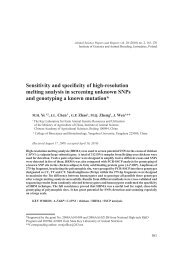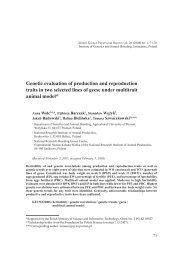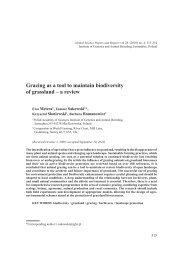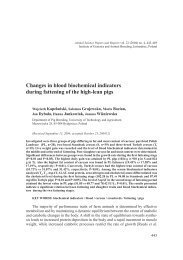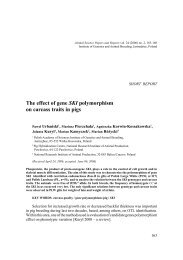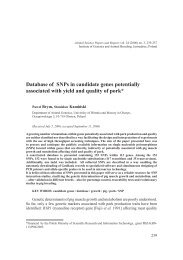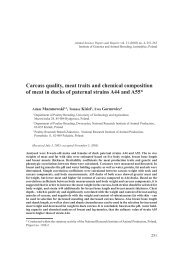in cattle and its implications for sex determination
in cattle and its implications for sex determination
in cattle and its implications for sex determination
You also want an ePaper? Increase the reach of your titles
YUMPU automatically turns print PDFs into web optimized ePapers that Google loves.
Animal Science Papers <strong>and</strong> Reports vol. 24 (2006) no. 2, 111-118<br />
Institute of Genetics <strong>and</strong> Animal Breed<strong>in</strong>g, Jastrzębiec, Pol<strong>and</strong><br />
A novel variant of the amelogen<strong>in</strong> gene (AMEL-X)<br />
<strong>in</strong> <strong>cattle</strong> <strong>and</strong> <strong>its</strong> <strong>implications</strong> <strong>for</strong> <strong>sex</strong> determ<strong>in</strong>ation<br />
Grzegorz Grzybowski, Beata Prusak, Bartosz Romaniuk<br />
Polish Academy of Sciences Institute of Genetics <strong>and</strong> Animal Breed<strong>in</strong>g,<br />
Jastrzębiec, 05-552 Wólka Kosowska, Pol<strong>and</strong><br />
(Received May 8, 2006; accepted June 8, 2006)<br />
The amelogen<strong>in</strong> gene (AMEL) is often used <strong>in</strong> the research requir<strong>in</strong>g <strong>sex</strong> determ<strong>in</strong>ation of humans<br />
<strong>and</strong> animals. In Bos taurus the most strik<strong>in</strong>g difference between the X- <strong>and</strong> Y-chromosomal AMEL<br />
genes is the 63 bp deletion <strong>in</strong> exon 6 of the Y-l<strong>in</strong>ked copy. Size differences <strong>in</strong> the gene AMEL between<br />
the <strong>sex</strong> chromosomes are used <strong>for</strong> embryo <strong>sex</strong><strong>in</strong>g as well as <strong>in</strong> <strong>for</strong>ensic casework, prenatal diagnosis,<br />
etc. The present paper shows that <strong>sex</strong> determ<strong>in</strong>ation of <strong>cattle</strong> samples based on DNA siz<strong>in</strong>g of gene<br />
AMEL is probably more complex than it was hitherto supposed.<br />
Used were 363 cows <strong>and</strong> 262 bulls of different breeds. Accord<strong>in</strong>g to a new polymorphism revealed <strong>in</strong><br />
gene AMEL <strong>in</strong> chromosome X <strong>in</strong> both the homo- <strong>and</strong> heterogametic <strong>sex</strong>, the novel PCR fragments<br />
of atypical size can be detected.<br />
KEYWORDS: <strong>cattle</strong> / amelogen<strong>in</strong> gene / chromosome X<br />
Simple <strong>and</strong> precise methods <strong>for</strong> <strong>sex</strong> determ<strong>in</strong>ation <strong>in</strong> animals are a pre-requisite<br />
<strong>for</strong> a number of applications <strong>in</strong> animal production <strong>and</strong> <strong>for</strong>ensic casework. For<br />
example, manipulation of the live-born <strong>sex</strong> ratio of <strong>cattle</strong> would give rise to a more<br />
flexible breed<strong>in</strong>g <strong>and</strong> production strategy [Grzybowski <strong>and</strong> Dymnicki 1997]. Genetic<br />
difference between male <strong>and</strong> female is the presence or absence of chromosome Y.<br />
There<strong>for</strong>e, many of exist<strong>in</strong>g methods <strong>for</strong> <strong>sex</strong> identification are based exclusively on<br />
the detection of sequences specific <strong>for</strong> chromosome Y [Bondioli et al. 1989, Herr et al.<br />
1990, Schröder et al. 1990, Wayda et al. 1995]. However, the absence of a signal does<br />
not necessarily mean that the sample is of female orig<strong>in</strong>, as negative results may also<br />
be generated by experimental errors. Thus, the detection of Y- <strong>and</strong> X-chromosome<br />
specific sequences is advantageous. Amelogen<strong>in</strong> gene (AMEL), the orig<strong>in</strong> of which<br />
111
G. Grzybowski et al.<br />
has been traced back to the Precambrium period [Delgado et al. 2001] has been used<br />
as a model <strong>in</strong> the field of molecular phylogenetics [Delgado et al. 2005, Toyosava et<br />
al. 1998] as well as <strong>in</strong> the analyses of biological traces aim<strong>in</strong>g at determ<strong>in</strong><strong>in</strong>g the <strong>sex</strong><br />
<strong>in</strong> humans <strong>and</strong> animals [Sullivan et al. 1993, Ennis <strong>and</strong> Gallagher 1994, Reklewski<br />
et al. 1996, Lechniak <strong>and</strong> Cumm<strong>in</strong>g 1997, Miścicka-Śliwka et al. 1997, Pfeiffer <strong>and</strong><br />
Brenig 2005]. The genes <strong>for</strong> enamel matrix prote<strong>in</strong>s (i.e. amelogen<strong>in</strong>, enamel<strong>in</strong> <strong>and</strong><br />
ameloblast<strong>in</strong> – EMPs) belong to a family compris<strong>in</strong>g also milk case<strong>in</strong>s <strong>and</strong> salivary<br />
prote<strong>in</strong>s <strong>and</strong> descend from a common ancestor by t<strong>and</strong>em duplication. EMP genes<br />
rema<strong>in</strong> l<strong>in</strong>ked, with the except <strong>for</strong> amelogen<strong>in</strong>. In eutherians (e.g. <strong>cattle</strong>, human,<br />
horse, black bear, monkeys), a copy of AMEL is present on each <strong>sex</strong> chromosome,<br />
while the gene is autosomal <strong>in</strong> monotremata, marsupialia <strong>and</strong> non-mammalian species<br />
[Sire et al. 2005]. The gene AMEL is generally known to be composed of seven exons<br />
[Delgado et al. 2005]. The hydrophobic, central region of exon 6 (approx. 300 bp),<br />
is the most variable compared to the other exons <strong>and</strong> to the 5’<strong>and</strong> 3’ regions, which<br />
are hydrophilic <strong>and</strong> show a high sequence similarity [Sire et al. 2005]. The X- <strong>and</strong> Y-<br />
l<strong>in</strong>ked amelogen<strong>in</strong> loci do not evolve <strong>in</strong> concert, <strong>and</strong> several differences (substitutions<br />
<strong>and</strong> <strong>in</strong>dels) have arisen between the copies. In Bos taurus the most strik<strong>in</strong>g difference<br />
between the X- <strong>and</strong> Y-chromosomal AMEL genes is the 63 bp deletion <strong>in</strong> exon 6 of<br />
the Y-l<strong>in</strong>ked copy [Gibson et al. 1991, 1992]. Size differences <strong>in</strong> AMEL between<br />
these chromosomes have been used <strong>for</strong> embryo <strong>sex</strong><strong>in</strong>g, <strong>in</strong> <strong>for</strong>ensic casework, prenatal<br />
diagnosis, etc.<br />
The aim of this paper was to demonstrate that determ<strong>in</strong>ation of <strong>sex</strong> of <strong>cattle</strong><br />
samples based on DNA siz<strong>in</strong>g technology of gene AMEL is presumably more complex<br />
than is usually assumed. Bas<strong>in</strong>g on a new deletion <strong>in</strong> gene AMEL discovered <strong>in</strong> this<br />
study <strong>in</strong> chromosome X it is anticipated that the novel PCR fragments of atypical size<br />
can be detected. Such fragments can alter the results of sample identification.<br />
112<br />
Material <strong>and</strong> methods<br />
The material covered a total of 363 cows <strong>and</strong> 262 bulls with typical karyotypes.<br />
The cows were Polish Red (PR, n=150), Polish Whiteback (PWb, n=72), Red-<strong>and</strong>-<br />
White (RW, n=72), <strong>and</strong> Black-<strong>and</strong>-White with Holste<strong>in</strong>-Friesian blood share (BW,<br />
n=69). The male material consisted of 12 PR, 30 RW, 125 BW with Holste<strong>in</strong>-Friesian<br />
blood share, 67 purebred Holste<strong>in</strong>-Friesian <strong>and</strong> 7 bulls of various beef breeds.<br />
Moreover, used were 6 young PWb <strong>and</strong> 15 young PR bull-calves.<br />
Genomic DNA was extracted from blood samples us<strong>in</strong>g Wizard® Genomic DNA<br />
Purification Kit (PROMEGA, USA). The polymerase cha<strong>in</strong> reaction (PCR) primers<br />
were those described by Ennis <strong>and</strong> Gallagher [1994]. PCR reaction was per<strong>for</strong>med<br />
<strong>in</strong> a volume of 10 µl us<strong>in</strong>g 1 µl of template DNA (approximately 50 ng), 1 unit of<br />
AmpliTaqGold (APPLIED BIOSYSTEMS) with reaction buffer consist<strong>in</strong>g of 50<br />
mM KCl, 10mM tris-HCl pH 8.3, 1.5mM MgCl 2<br />
, 200 µM each dNTP <strong>and</strong> 0.05-0.18<br />
µM of each primer. The PCR products were separated <strong>in</strong> 5% Long Ranger gel (FMC
A novel variant of the amelogen<strong>in</strong> gene <strong>in</strong> <strong>cattle</strong><br />
BIOPRODUCTS) on an ABI PRISM 377 DNA sequencer (APPLIED BIOSYSTEMS)<br />
us<strong>in</strong>g GeneScan-500 <strong>in</strong>ternal size st<strong>and</strong>ard. Fragment sizes were determ<strong>in</strong>ed us<strong>in</strong>g<br />
GeneScan v.3.1 software (APPLIED BIOSYSTEMS).<br />
Results <strong>and</strong> disscussion<br />
Primer pairs used <strong>for</strong> amplification of exon 6 of the bov<strong>in</strong>e gene AMEL produced<br />
the 215 bp fragment specific <strong>for</strong> chromosome Y <strong>and</strong> 278 bp fragment specific <strong>for</strong><br />
chromosome X. Typical pattern <strong>for</strong> the heterogametic <strong>sex</strong> (XY karyotype) comprised<br />
one fragment of 215 bp <strong>and</strong> one of 278 bp (Fig. 1-a), while that <strong>for</strong> homogametic <strong>sex</strong><br />
(XX karyotype) consisted of two fragments of 278 bp generat<strong>in</strong>g s<strong>in</strong>gle detection signal<br />
(Fig. 1-b). Accord<strong>in</strong>g to preasumption presented, the test<strong>in</strong>g result <strong>for</strong> homogametic<br />
<strong>sex</strong> should always be “homozygous”, whereas “heterozygous” phenotype should<br />
always appear <strong>for</strong> heterogametic <strong>sex</strong>. Additionally, the PCR products specific <strong>for</strong><br />
chromosome X <strong>and</strong> Y must have the constant position <strong>in</strong> a separat<strong>in</strong>g medium,<br />
correspond<strong>in</strong>g exactly to the fragment size of 278 bp <strong>and</strong> 215 bp.<br />
a<br />
b<br />
Fig. 1. Electrophoregrams show<strong>in</strong>g the amelogen<strong>in</strong> gene amplicon from a blood sample withdrawn from:<br />
a - cow of genotype 278/278; b - bull of genotype 215/278.<br />
113
G. Grzybowski et al.<br />
The typical size <strong>for</strong> the PCR product <strong>for</strong> chromosome X was observed <strong>for</strong> the<br />
majority of animals tested. Only <strong>for</strong> 24 PR cows <strong>and</strong> two PR bulls a novel variant<br />
<strong>for</strong> amelogen<strong>in</strong> gene <strong>in</strong> chromosome X was found, non hitherto reported. In addition<br />
to typical PCR product of 278 bp length a fragment of a smaller size, i.e. 269 bp<br />
appeared (Fig. 2-a <strong>and</strong> Fig. 2-b).<br />
a<br />
b<br />
Fig. 2. Electrophoregrams show<strong>in</strong>g the amelogen<strong>in</strong> gene amplicon from a blood sample withdrawn from:<br />
a - cow of genotype 269/278; b - bull ofgenotype 215/269<br />
Review of relevant literature <strong>in</strong>dicates that polymorphism <strong>in</strong> gene AMEL on<br />
chromosome X has not been hitherto detected, while <strong>in</strong> the sequence of AMEL <strong>in</strong><br />
chromosome Y many differences have been reported. In addition to the characteristic<br />
deletion of 63 bp <strong>in</strong> exon 6, there are 41 s<strong>in</strong>gle-nucleotide differences between the<br />
X <strong>and</strong> Y gene-cod<strong>in</strong>g regions. There are 13 am<strong>in</strong>o acid differences <strong>in</strong>clud<strong>in</strong>g six<br />
conservative <strong>and</strong> five non-conservative changes <strong>in</strong> the secreted prote<strong>in</strong> plus two<br />
differences <strong>in</strong> the signal sequence [Gibson et al. 1992]. S<strong>in</strong>ce <strong>in</strong> placental mammals<br />
both the gene <strong>and</strong> prote<strong>in</strong> sequences of amelogen<strong>in</strong> are highly conservative [Sire et al.<br />
2005], detection of novel sequence variant <strong>in</strong> <strong>cattle</strong> AMEL is surpris<strong>in</strong>g. The sequence<br />
was <strong>in</strong>troduced <strong>in</strong>to GenBank (accession nos. Q99004 <strong>and</strong> M63499) <strong>and</strong> is considered<br />
114
A novel variant of the amelogen<strong>in</strong> gene <strong>in</strong> <strong>cattle</strong><br />
as the reference sequence <strong>for</strong> <strong>cattle</strong> gene AMEL-X. The only possible explanation <strong>for</strong><br />
the phenomenon of detection of two different PCR products <strong>for</strong> homogametic <strong>sex</strong><br />
(278 bp <strong>and</strong> 269 bp) could be a deletion with<strong>in</strong> the anneal<strong>in</strong>g region of the primers.<br />
Variant AMEL-X(269) was identified exclusively <strong>in</strong> PR <strong>cattle</strong>, <strong>in</strong>dicat<strong>in</strong>g that<br />
the detected deletion is breed-specific. It seems that <strong>in</strong><strong>for</strong>mation about existence of<br />
AMEL-X(269) <strong>in</strong> <strong>cattle</strong> genome could be useful <strong>for</strong> appropriate manag<strong>in</strong>g of PR <strong>cattle</strong><br />
preservation programme. An analysis of the DNA microsatellite alleles confirmed that<br />
80% of PR animals <strong>in</strong>cluded <strong>in</strong> the Polish National Rare Livestock Breeds Preservation<br />
Programme (NRLBPP) comprised a separate genetic group with high level of genetic<br />
diversity, differ<strong>in</strong>g from the other European <strong>cattle</strong> populations [Lubieniecka et al.<br />
2001]. Identification of hitherto unknown variant of gene AMEL occurr<strong>in</strong>g only <strong>in</strong> PR<br />
<strong>cattle</strong> confirms this op<strong>in</strong>ion.<br />
Comparison of bov<strong>in</strong>e AMEL sequence (GenBank accession nos. Q99004 <strong>and</strong><br />
M63499) with those identified <strong>in</strong> 26 species represent<strong>in</strong>g ma<strong>in</strong> taxonomic groups of<br />
mammals [Toyosava et al. 1998, Delgado et al. 2005] leads to the conclusion that<br />
detected deletion of 9 bp is located <strong>in</strong> the region of exon 6 which, <strong>in</strong> turn, is considered<br />
as a mutational hot spot <strong>in</strong> mammalian AMEL gene. Many differences <strong>in</strong> this region<br />
have been detected between taxonomic groups, but on the species level both the gene<br />
<strong>and</strong> prote<strong>in</strong> sequence are highly conservative [Toyosava et al. 1998, Delgado et al.<br />
2005] presumably due to selection pressure. The number of variations observed <strong>in</strong><br />
AMEL-Y vs AMEL-X sequences <strong>in</strong>dicate that both genes were not subjected to the<br />
same evolutionary constra<strong>in</strong>ts [Delgado et al. 2005]. Thus, it seems particularly<br />
important to verify whether amelogen<strong>in</strong> prote<strong>in</strong> coded by the new gene variant<br />
AMEL-X(269) ma<strong>in</strong>ta<strong>in</strong>s <strong>its</strong> normal biological efficiency. Given the predom<strong>in</strong>ance of<br />
amelogen<strong>in</strong> <strong>in</strong> <strong>for</strong>m<strong>in</strong>g enamel matrix, one can easily underst<strong>and</strong> that defects <strong>in</strong> the<br />
AMEL structure <strong>and</strong>/or organization have a detrimental effect on enamel <strong>for</strong>mation.<br />
Twelve mutations (either deletions or substitutions of nucleotides) <strong>in</strong> the human<br />
amelogen<strong>in</strong> gene sequence have been reported to be responsible <strong>for</strong> various types<br />
of amelogenesis imperfecta [Hart et al. 2002]. In humans, the structural defects that<br />
lead to several cases of the disease concern only AMEL-X (X-l<strong>in</strong>ked effects). In light<br />
of important consequences <strong>for</strong> enamel structure, such defects would probably be<br />
lethal <strong>in</strong> wild animals [Delgado et al. 2005]. It rema<strong>in</strong>s to be determ<strong>in</strong>ed whether both<br />
genes on the X <strong>and</strong> Y chromosomes are functional. So far, the function of amelogen<strong>in</strong><br />
prote<strong>in</strong>s coded by AMEL-Y rema<strong>in</strong>s unknown [Delgado et al. 2005]. The sequence<br />
of the Y-l<strong>in</strong>ked gene is probably not under strong functional constra<strong>in</strong>t as possible<br />
<strong>in</strong>activat<strong>in</strong>g mutations are masked by the X-l<strong>in</strong>ked gene. The eutherian Y-l<strong>in</strong>ked copy<br />
may, there<strong>for</strong>e, be tend<strong>in</strong>g towards pseudogene status [Toyosava 1998, Gibson et al.<br />
1992]. In <strong>for</strong>ensic cases it has been shown that some mutations identified <strong>in</strong> human<br />
gene AMEL-Y can lead to serious mistakes <strong>in</strong> <strong>sex</strong> determ<strong>in</strong>ation analyses. Several PCR<br />
primer sets have been developed, <strong>and</strong> the most commonly used PCR-based <strong>sex</strong> test<br />
was described by Sullivan et al. [1993], flank<strong>in</strong>g a 6 bp deletion on the X homologue,<br />
result<strong>in</strong>g <strong>in</strong> 106 bp <strong>and</strong> 112 bp PCR products from the human X <strong>and</strong> Y chromosomes,<br />
115
G. Grzybowski et al.<br />
respectively. Amelogen<strong>in</strong>-based <strong>sex</strong> tests are part of various PCR multiplex reaction<br />
k<strong>its</strong> from different manufacturers <strong>and</strong> are videly used <strong>for</strong> DNA typ<strong>in</strong>g of both reference<br />
<strong>and</strong> casework samples <strong>in</strong> the <strong>for</strong>ensic field, especially <strong>for</strong> DNA databas<strong>in</strong>g purposes.<br />
Reported cases of erroneous samples <strong>sex</strong><strong>in</strong>g based on gene AMEL [Ste<strong>in</strong>lechner et al.<br />
2002, Thangaraj et al. 2002] resulted from deletion <strong>in</strong> the sequence of AMEL-Y gene<br />
copy <strong>and</strong> <strong>in</strong> consequence from the lack of amplification of gene fragment specific<br />
<strong>for</strong> chromosome Y. In these cases the samples analysed were erroneously assigned<br />
to homogametic <strong>sex</strong>, i.e. women. The frequency of so-called „deleted-amelogen<strong>in</strong><br />
males” was estimated to 0.018% [Ste<strong>in</strong>lechner et al. 2002]. In <strong>cattle</strong>, any changes<br />
<strong>in</strong> sequence of AMEL-Y gene copy <strong>in</strong>fluenc<strong>in</strong>g <strong>sex</strong><strong>in</strong>g results have not hitherto<br />
been reported. In the present paper we discuss other aspects of possible problems<br />
that could arise <strong>in</strong> connection with new polymorphism discovered <strong>in</strong> gene AMEL <strong>in</strong><br />
chromosome X. Namely, the phenotypic pattern of <strong>sex</strong> could be more complex s<strong>in</strong>ce<br />
the presence of two variants <strong>for</strong> AMEL on chromosome X: AMEL-X (278 bp) <strong>and</strong><br />
AMEL-X (269 bp) results <strong>in</strong> five genotypes possibly exist<strong>in</strong>g <strong>in</strong> <strong>cattle</strong>. Three concern<br />
cows: 278 bp/278 bp, 269 bp/269 bp <strong>and</strong> 269 bp/278 bp whilst two presumably exist<br />
<strong>in</strong> bulls: 215 bp/278 bp <strong>and</strong> 215 bp/269 bp. In this study we identified all possible<br />
genotypes with the exception of the genotype homozygous <strong>for</strong> 269 bp variant. Results<br />
presented are contrary to widely hitherto spread conviction that homogametic <strong>sex</strong> is<br />
always detected as “homozygous” phenotype. However, <strong>in</strong> heterogametic <strong>sex</strong> PCR<br />
products <strong>for</strong> X <strong>and</strong> Y chromosomes are of different length <strong>and</strong> thus the phenotype<br />
is “heterozygous”, but besides normal pattern the occurrence of pattern with a new<br />
shorter variant is also possible. The problems with correct <strong>sex</strong> determ<strong>in</strong>ation can arise<br />
particularly dur<strong>in</strong>g analys<strong>in</strong>g the old, degraded or contam<strong>in</strong>ated samples when the<br />
risk of detection of unspecific products of length similar to specific PCR products is<br />
higher. There<strong>for</strong>e, <strong>in</strong> questionable cases of test<strong>in</strong>g unknown samples the need of result<br />
verification by direct sequenc<strong>in</strong>g of amplified PCR products could be necessary.<br />
1.<br />
2.<br />
3.<br />
4.<br />
5.<br />
REFERENCES<br />
BONDIOLI K.R., ELLIS S.B., PRYOR J.H., WILLIAMS M.W., HARPOLD M.M., 1989 –<br />
The use male-specific chrmosomal DNA fragments to determ<strong>in</strong>e the <strong>sex</strong> of bov<strong>in</strong>e preimplantation<br />
embryos. Theriogenology 31, 95-103.<br />
DELGADO S., CASANE D., BONNAUD L., LAURIN M., SIRE J-Y., GIRONDOT M., 2001<br />
– Molecular evidence <strong>for</strong> Precambrian orig<strong>in</strong> of amelogen<strong>in</strong>, the major prote<strong>in</strong> of vertebrate enamel.<br />
Molecular Biology <strong>and</strong> Evolution 18(12), 2146-2153.<br />
DELGADO S., GIRONDOT M., SIRE J-Y., 2005 – Molecular evolution of amelogen<strong>in</strong> <strong>in</strong> mammals.<br />
Journal of Molecular Evolution 60, 12-30.<br />
ENNIS S., GALLAGHER T.F., 1994 – A PCR-based <strong>sex</strong> determ<strong>in</strong>ation assay <strong>in</strong> <strong>cattle</strong> based on the<br />
amelogen<strong>in</strong> locus. Animal Genetics 25, 425-427.<br />
GIBSON C., GOLUB E., HEROLD R., RISSER M., DING W., SHIMOKAWA H., YOUNG<br />
M., TERMINE J., ROSENBLOOM J., 1991 – Structure <strong>and</strong> expression of the bov<strong>in</strong>e amelogen<strong>in</strong>e<br />
gene. Biochemistry 30, 1075-1079.<br />
116
A novel variant of the amelogen<strong>in</strong> gene <strong>in</strong> <strong>cattle</strong><br />
6.<br />
7.<br />
8.<br />
9.<br />
10.<br />
11.<br />
12.<br />
13.<br />
14.<br />
15.<br />
16.<br />
17.<br />
18.<br />
19.<br />
20.<br />
21.<br />
GIBSON C.W., GOLUB E.E., ABRAMS W.R., SHEN G., DING W., ROSENBLOOM J.,<br />
1992 – Bov<strong>in</strong>e amelogen<strong>in</strong> message heterogeneity: Alternative splic<strong>in</strong>g <strong>and</strong> Y-chromosome gene<br />
transcription. Biochemistry 31, 8384-8388.<br />
GRZYBOWSKI G., DYMNICKI E., 1997 – Metody oraz ekonomiczne znaczenie sterowania<br />
proporcją płci u bydła. Biotechnologia 3 (38), 38-50.<br />
HART P.S., HART T.C., SIMMER J.P., WRIGHT J.T., 2002 – A nomenclature <strong>for</strong> X-l<strong>in</strong>ked<br />
amelogenesis imperfecta. Archives of Oral Biology 47, 255-260.<br />
HERR C.M., HOLT N.A., MATTHAEI K.I., REED K.C., 1990 – Sex progeny from bov<strong>in</strong>e<br />
embryos <strong>sex</strong>ed with a rapid Y-chromosome-detection assay. Theriogenology 33, 247.<br />
LECHNIAK D., CUMMING I.R., 1997 – The use of amelogen<strong>in</strong> gene polymorphism <strong>in</strong> PCR<br />
embryo <strong>sex</strong><strong>in</strong>g <strong>in</strong> bov<strong>in</strong>e IVF embryos. Journal of Applied Genetics 38 (1), 45-49.<br />
LUBIENIECKA J., GRZYBOWSKI G., LUBIENIECKI K., 2001 – Genetic variation <strong>in</strong> n<strong>in</strong>e<br />
European <strong>cattle</strong> breeds as determ<strong>in</strong>ed on the basis of microsatellite markers. I. With<strong>in</strong>-breed variation.<br />
Animal Science Papers <strong>and</strong> Reports 19 (4), 249-264.<br />
MIŚCICKA-ŚLIWKA D., GRZYBOWSKI T., WOŹNIAK M., 1997 – Optimization of a hexaplex<br />
DNA amplification from short t<strong>and</strong>em repeat <strong>and</strong> amelogen<strong>in</strong> loci. Electrophoresis 18, 1627-1632.<br />
PFEIFFER I., BRENIG G.B., 2005 – X- <strong>and</strong> Y-chromosome specific variants of the amelogen<strong>in</strong><br />
gene allow <strong>sex</strong> determ<strong>in</strong>ation <strong>in</strong> sheep (Ovis aries) <strong>and</strong> European red deer (Cervus elaphus). BMC<br />
Genetics 6, 16.<br />
REKLEWSKI T., GRZYBOWSKI G., LUBIENIECKI K., 1996 – Sex identification <strong>in</strong> <strong>cattle</strong> on the<br />
basis of amelogen<strong>in</strong> polymorphism. Živočišna Výroba 41 (11), 504-505.<br />
SCHRÖDER A., MILLER J.R., THOMSEN P.D., ROSCHLAU K., AVERY B., POULSEN<br />
P.H., SCHMIDT M., SCHWERIN M., 1990 – Sex determ<strong>in</strong>ation of bov<strong>in</strong>e embryos us<strong>in</strong>g the<br />
polymerase cha<strong>in</strong> reaction. Animal Biotechnology 1(2), 121-123.<br />
SIRE J-Y., DELGADO S., FROMENTIN D., 2005 – Amelogen<strong>in</strong>: lessons from evolution. Archives<br />
of Oral Biology 50, 205-212.<br />
STEINLECHNER M., BERGER B., NIEDERSTÄTTER H., PARSON W., 2002 – Rare failures <strong>in</strong><br />
the amelogen<strong>in</strong> <strong>sex</strong> test. International Journal of Legal Medic<strong>in</strong>e 116, 117-120.<br />
SULLIVAN K.M., MANNUCCI A., KIMPTON C.P., GILL P., 1993 – A rapid <strong>and</strong> quantitative<br />
DNA <strong>sex</strong> test: fluorescence-based PCR analysis of X-Y homologous gene amelogen<strong>in</strong>. Biotechniques<br />
15, 636-641.<br />
THANGARAJ K., REDDY A.G., SINGH L., 2002 – Is the amelogen<strong>in</strong> gene reliable <strong>for</strong> gender<br />
identification <strong>in</strong> <strong>for</strong>ensic casework <strong>and</strong> prenatal diagnosis? International Journal of Legal Medic<strong>in</strong>e<br />
116, 121-123.<br />
TOYOSAVA S., O , HUIGIN C., FIGUEROA F., TICHY H., KLEIN J., 1998 – Identification <strong>and</strong><br />
characterization of amelogen<strong>in</strong> genes <strong>in</strong> monotremes, reptiles, <strong>and</strong> amphibians. Proceed<strong>in</strong>gs of the<br />
National Academy of Sciences of the USA 95, 13056-13061.<br />
WAYDA E., PŁUCIENNICZAK G., JURA J., PŁUCIENNICZAK K., KĄTSKA L.,<br />
SKRZYSZOWSKA M., SMORĄG Z., 1995 – Molekularna metoda oznaczania płci zarodków<br />
bydlęcych wyhodowanych <strong>in</strong> vitro. Medycyna Weterynaryjna 51 (9), 530-532.<br />
117
G. Grzybowski et al.<br />
Grzegorz Grzybowski, Beata Prusak, Bartosz Romaniuk<br />
Nowy wariant genu AMEL-X u bydła oraz jego implikacje<br />
w seksowaniu próbek biologicznych<br />
S t r e s z c z e n i e<br />
W genomie bydła występują dwie kopie genu amelogen<strong>in</strong>y, umiejscowione w chromosomach<br />
płci (AMEL-X i AMEL-Y). Obecność charakterystycznej delecji 63 pz w szóstym eksonie kopii<br />
AMEL-Y sprawia, że amplifikując wspomniany obszar sekwencji w reakcji PCR, można odróżnić płeć<br />
homogametyczną od heterogametycznej (odpowiednio jeden lub dwa sygnały detekcji dla produktów<br />
PCR).<br />
Przebadano 625 kariotypowo normalnych krów (XX) i buhajów (XY) różnych ras z hodowli<br />
krajowej. Materiał żeński obejmował 150 krów rasy polskiej czerwonej, 72 krowy rasy białogrzbietej, 72<br />
rasy czerwono-białej i 69 rasy czarno-białej z udziałem genów bydła hf. W grupie osobników męskich<br />
analizami objęto 12 buhajów rasy polskiej czerwonej, 30 rasy czerwono-białej, 125 rasy czarno-białej<br />
z udziałem genów hf, 67 czystorasowych buhajów hf, 7 buhajów różnych ras mięsnych, 6 buhajków<br />
białogrzbietych oraz 15 buhajków rasy polskiej czerwonej.<br />
W kopii genu AMEL-X, u 24 krów i 2 buhajków rasy polskiej czerwonej zidentyfikowano obecność<br />
nowego wariantu charakteryzującego się delecją 9 pz. Wyniki dowodzą, że seksowanie próbek bydlęcych<br />
z wykorzystaniem polimorfizmu genu AMEL jest bardziej złożone niż dotychczas przyjmowano, gdyż<br />
u płci homogametycznej (XX) i heterogametycznej (XY) występować mogą odpowiednio – trzy i dwa<br />
różne fenotypy płci.<br />
118



